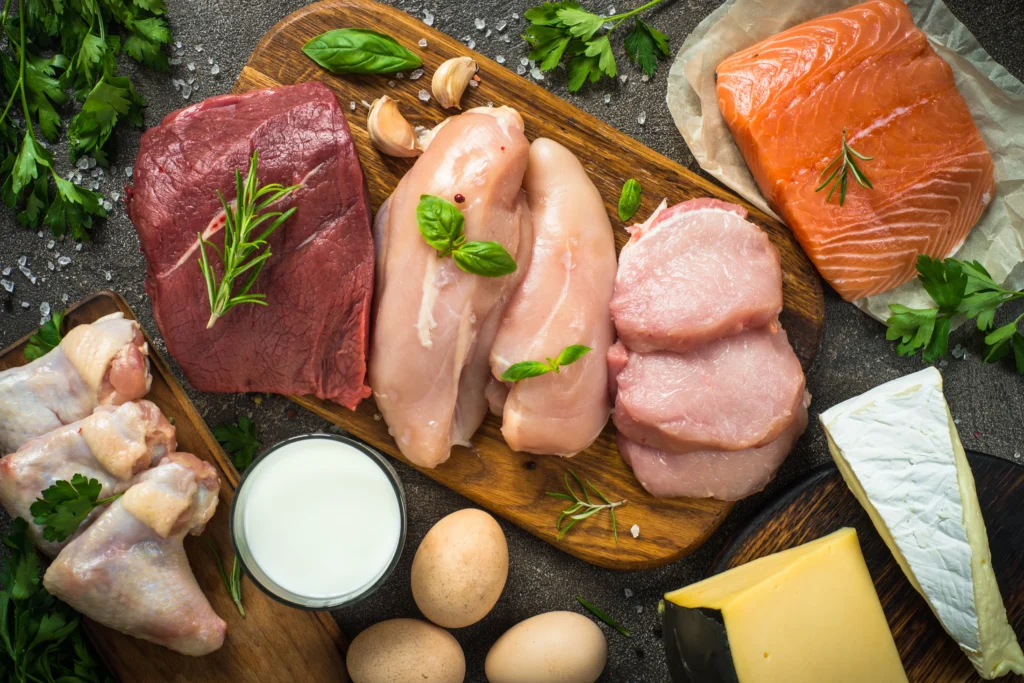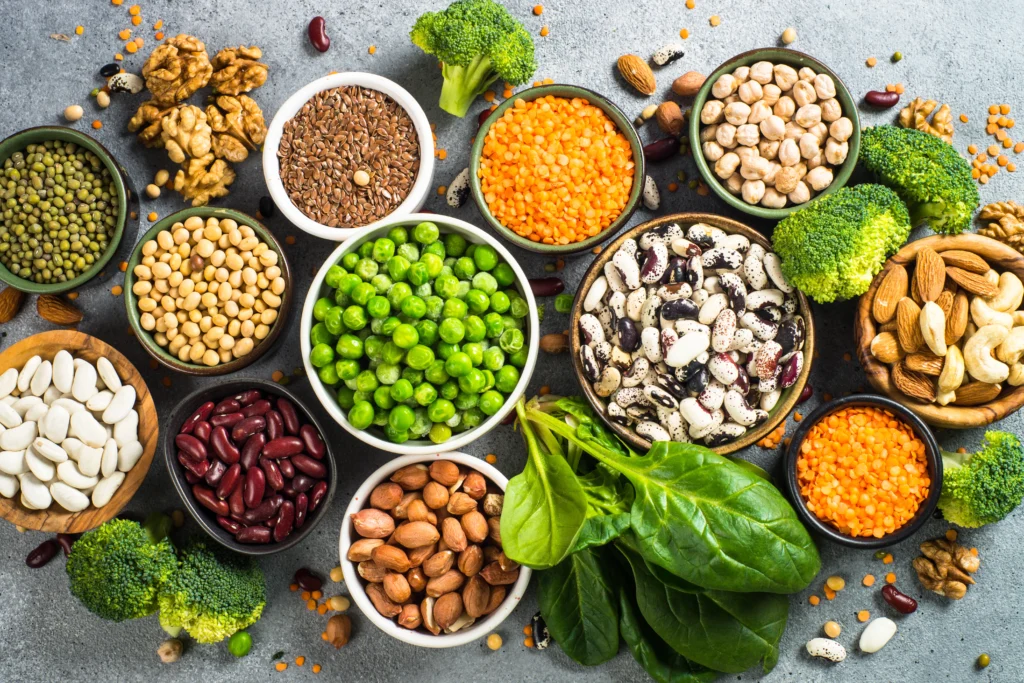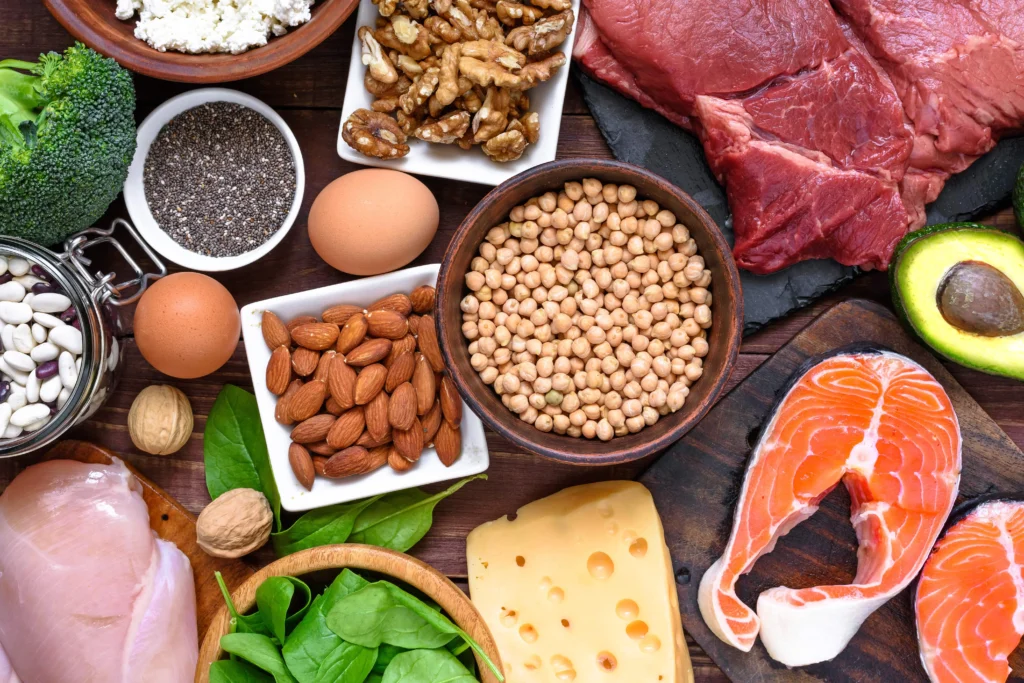Ditch the confusion and unlock a healthier you with good protein foods! It’s true, protein seems to be everywhere these days, from fitness influencers to fad diets. But navigating the sea of information can be overwhelming, leaving you unsure about what truly qualifies as “good.” Forget the jargon and limited options of other guides! This ultimate resource dives deep into the world of good protein foods, empowering you to make informed choices for a happier, healthier you.
Why does protein even matter? It’s the workhorse of your body, building and repairing everything from bones to organs. Not enough? Say hello to fatigue, muscle loss, and even weakened immunity. No thanks! ♀️
But here’s the catch: not all protein is created equal. Some leave you bloated and sluggish, while others fuel your body and mind like a champion. So, ditch the confusion and join me on this journey to discover the richest, tastiest, and most effective protein sources on the planet! From juicy lean meats to plant-based powerhouses, this guide has it all. Get ready to ditch the guesswork and unlock the true potential of good protein foods.
Ready to dive in? Let’s go!
Part 1: Animal Protein Sources:

So, you’re on the hunt for good protein foods? Wise move! Protein is like the construction crew for your body, building and repairing tissues, keeping you energized, and making you feel oh-so-satisfied. But with so many animal options out there, where do you start? Buckle up, protein explorers, because we’re diving deep into the delicious world of meat, poultry, fish, and dairy!
Lean Mean Machines:
Let’s begin with the classic – chicken breast. Packed with protein (around 22 grams per 3oz serving) and boasting minimal fat, it’s a fitness fanatic’s favorite. But let’s be honest, sometimes plain grilled chicken can get…well, plain. Fear not! This versatile champ shines in stir-fries, salads, sandwiches, and even gets cozy in cozy casseroles.
Now, turkey breast deserves a shout-out too. It’s leaner than some cuts of chicken (around 25 grams of protein per 3oz), making it a fantastic choice for weight management. Want to mix things up? Try ground turkey in your next burger or meatballs – you won’t regret it!
Beefing Up Your Protein Intake:
Craving something heartier? Lean beef cuts like round and flank are your protein-packed pals. Don’t shy away from the iron boost either – a 3oz serving packs around 25 grams of protein and a whopping 25% of your daily iron needs! Just remember, moderation is key, and opt for lean cuts to keep saturated fat in check. Speaking of moderation, how about a juicy pork tenderloin? This lean cut, clocking in at around 28 grams of protein per 3oz, satisfies without going overboard.
But wait, there’s more! Bison and ostrich are rising stars in the protein world, offering comparable protein content to beef with a lower fat profile. Feeling adventurous? Give them a try!
Swimming in Omega-3 Goodness:
Now, let’s dive into the ocean of protein-rich delights. Fatty fish like salmon, tuna, and mackerel are like superheroes in disguise. Not only do they provide protein (around 20-30 grams per 3oz serving), but they’re chock-full of Omega-3 fatty acids, essential for heart and brain health. Think grilled salmon with a side of roasted veggies, or a tuna salad sandwich packed with flavor and nutrients.
But don’t underestimate the power of lean fish like halibut, cod, and perch. These lower-calorie options, bursting with around 20 grams of protein per 3oz serving, are perfect for those watching their calorie intake. Try a baked cod with a lemon-herb crust, or a pan-seared halibut with a light, creamy sauce.
Shell Yeah, Sustainability Matters:
Before we leave the ocean, let’s talk about making responsible choices. When selecting seafood, opting for eco-friendly options is crucial. Check out organizations like the Monterey Bay Aquarium Seafood Watch program to guide your selections and ensure a healthy planet for future generations.
Egg-cellent Choice, and Dairy Delights:
Finally, let’s not forget the land-based protein powerhouses. Eggs are an affordable, complete protein source with around 6 grams per large egg. Whether you scramble, fry, poach, or bake them, eggs are a breakfast (or brunch, or lunch, or dinner!) winner.
Greek yogurt deserves a standing ovation too. This protein-packed (around 20 grams per 7oz serving) and low-sugar champ is a fantastic snack or ingredient in dips, smoothies, or even baked goods. And of course, cottage cheese is a timeless low-fat, calcium-rich (around 14 grams of protein per ½ cup) delight. Don’t be afraid to get creative – mix it with fruits, veggies, or herbs for a flavor explosion!
Remember, variety is key! Explore different good protein foods to find your favorites and fuel your body with the nutrients it needs to thrive. Now, tell me in the comments: what are your go-to animal protein sources? Let’s share our protein journeys and inspire each other!
Part 2: Plant-Based Protein Sources:

Hold the meat, raise the lentils! Forget the stereotypical image of bland, boring vegetarian meals. The plant-based world is bursting with good protein foods that’ll tantalize your taste buds and fuel your body. Let’s dive into the diverse realm of legumes, nuts, seeds, and more, exploring their protein punch and unlocking a treasure trove of culinary possibilities.
Legume Love: Tiny Seeds, Mighty Protein Packs
Lentils: Don’t underestimate these little marvels! Packing a whopping 18 grams of protein per cup, cooked, they’re also fiber champs, keeping you feeling full and satisfied. Plus, they’re incredibly versatile, starring in soups, stews, salads, and even veggie burgers. So, tell me, how do you like your lentils best?
Black Beans: They’re not just for tacos (although they rock in those too)! Black beans offer a hefty 15 grams of protein per cup, along with a dose of iron and folate. Their rich, earthy flavor shines in burritos, dips, and even brownies (yes, you read that right!). Have you tried any unique black bean recipes? Share your secrets in the comments!
Chickpeas: The hummus hero takes center stage! One cup of chickpeas boasts 14 grams of protein, making them a delicious and nutritious base for dips, curries, and falafel. But their power doesn’t stop there! Roast them for a crunchy snack, toss them into salads, or blend them into creamy sauces. So, are you team hummus or exploring new chickpea horizons?
Nutty Delights: Tiny Bites, Big Benefits
Almonds: Protein powerhouse alert! Just a ¼ cup of almonds delivers 6 grams of protein, alongside healthy fats and fiber. Snack on them raw, blend them into nut butter, or sprinkle them over salads and yogurt. But remember, moderation is key, as these little gems pack a calorie punch too! What’s your favorite way to enjoy almonds?
Pumpkin Seeds: Don’t relegate these to carving jack-o’-lanterns! Pumpkin seeds are nutritional superstars, offering 5 grams of protein per ¼ cup, along with magnesium and zinc. Sprinkle them on smoothies, soups, or stir-fries for a satisfying crunch and a boost of nutrients. Do you have any creative pumpkin seed uses to share?
Chia Seeds: Tiny but mighty, chia seeds are protein and omega-3 powerhouses, delivering 4 grams of protein per 2 tablespoons. Add them to pudding, oatmeal, or even water for a gel-like consistency and a burst of nutrition. But be warned, they can absorb a lot of liquid, so start slow and stay hydrated! Have you discovered any interesting ways to use chia seeds?
Tofu & Tempeh: Soybeans Step Up to the Plate
Tofu: This versatile blank canvas soaks up flavors like a champ, offering around 8 grams of protein per ½ cup. Whether you scramble it, stir-fry it, or bake it, tofu can be a delicious and protein-rich star in countless dishes. What are your favorite tofu creations? Tell us your secrets! ✨
Tempeh: Made from fermented soybeans, tempeh boasts a nutty flavor and a slightly higher protein content than tofu, clocking in at around 16 grams per ½ cup. Its fermented goodness also adds beneficial probiotics to your gut. Have you tried tempeh yet? If so, what are your favorite ways to prepare it?
Remember, variety is key! Don’t limit yourself to just one or two good protein foods. Explore the diverse world of plant-based options, experiment with flavors and textures, and discover what delights your taste buds while nourishing your body. So, unleash your plant-powered protein creativity and share your culinary adventures in the comments below!
Part 3: Optimizing Your Protein Intake:

Ever wondered how much protein YOU actually need? It’s not a one-size-fits-all answer! Your age, activity level, and even health goals all play a role. A registered dietitian can help you calculate your personalized protein needs, but a general rule of thumb is 0.8 grams per kilogram of body weight.
But it’s not just about quantity, friends! Quality matters too. Aim for a diverse platter of good protein foods – think lean meats, fish, eggs, dairy, legumes, nuts, and seeds. These protein powerhouses offer a spectrum of essential amino acids, the building blocks your body craves. Want to maximize your muscle-building potential? Combine complementary protein sources throughout the day, like brown rice and beans or chicken and quinoa.
Speaking of throughout the day, ⏰ did you know spreading your protein intake evenly across meals and snacks can support sustained energy and satiety? Feeling overwhelmed by meal planning? Don’t sweat it! Start with small changes. Add a scrambled egg to your breakfast, sprinkle nuts on your salad, or whip up a protein smoothie for an afternoon pick-me-up.
And for our plant-powered peeps! Don’t worry, getting enough protein on a vegetarian or vegan diet is totally doable. Embrace the versatility of lentils, chickpeas, tofu, tempeh, and quinoa. Plus, don’t forget about sneaky protein sources like leafy greens, broccoli, and even chia seeds!
Remember, the journey to optimal protein intake is a personal one. ♀️ So explore, experiment, and find what works best for you! ✨ Remember, a balanced diet rich in good protein foods is key to keeping your body and mind functioning at their peak!
P.S. Feeling lost in the protein wilderness? Check out the incredible resources below for more guidance!
Fuel Your Potential: The Protein Powerhouse Conclusion:

Remember, good protein foods aren’t just about numbers on a label. They’re about vibrant energy, sculpted muscles, and a happy, healthy you. But the journey doesn’t stop here. Explore the diverse world of protein – from juicy salmon to creamy Greek yogurt, and earthy lentils to crunchy almonds. Each offers a unique taste and nutrient profile, waiting to supercharge your day. So, tell us, what delicious protein source will you try next? And don’t forget to share your experiences and questions in the comments below! Let’s build a community that thrives on the power of good protein foods.
P.S. Still unsure about your daily protein needs or the best sources for your goals? Check out our informative FAQs and trusted external resources – we’ve got you covered!
You Can Read: protein foods list for weight loss
People Also Ask:
Unsure how much protein you need?
Dreaming of a leaner you?
Building muscle on your mind?
Worried about overdoing protein?
Going vegetarian or vegan?
What foods are highest in protein?
Plant-based sources: Lentils, chickpeas, and tofu are excellent plant-based protein options. Nuts and seeds like almonds and chia seeds are also good sources.
What are the top 20 protein foods?
Chicken breast
Greek yogurt
Tuna
Salmon
Lean beef
Eggs
Lentils
Black beans
Turkey breast
Cottage cheese
Chickpeas
Almonds
Pumpkin seeds
Tofu
Edamame
Milk
Quinoa
Chia seeds
Broccoli
Brussels sprouts
How to get 150g of protein a day?
Spread protein throughout your day: Include protein in all meals and snacks.
Combine protein sources: Pair lean meats with legumes, eggs with veggies, or nuts with yogurt.
Choose protein-rich ingredients: Opt for Greek yogurt over regular yogurt, lentils over pasta, or tofu scramble over eggs.
What is the healthiest protein?
Overall health: Choose lean protein sources with minimal saturated fat and cholesterol.
Dietary restrictions: Explore plant-based options if you’re vegetarian or vegan.
Nutrient profile: Select protein sources rich in essential vitamins and minerals.